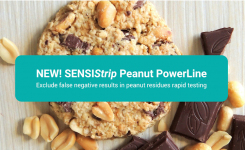
Introduction
Food allergies are a health issue that affects millions of people worldwide. It is estimated that approximately 30,000 Americans attend the ER to be treated for severe food allergies and about 150-200 of them die every year. In Europe, food allergies affect more than 17 million people; 3.5 million of them are younger than 25 years.
An allergic reaction to food happens when our immune system treats certain proteins as if they were pathogens. Depending on the exposure to the substance and the severity of the allergy, consequences can vary from a simple skin rash or itch in the mouth to anaphylactic shock and death.
It is still not clear why some people develop food allergies or certain foods cause allergic reactions and no cure exists at the moment. The only way to avoid them is to have no contact with food allergens altogether.
Food labelling regulations require companies to highlight the presence of allergens on the packaging, whether as one of the main ingredients or as a possible presence. The food label is therefore the single most important means of communication to consumers. The health – and often life - of many consumers depends on the correctness of its information.
Food labelling requirements, however, do not apply to all foods that can cause allergies (there are more than 160 of them), but only to the main ones, either the most frequent among the population (and also the ones we see most often in food recall reports) like milk and eggs, or those with the most dangerous consequences, like fish and shellfish.
The Codex Alimentarius provides a basic list of these main food allergens: cereals containing gluten, crustacea, eggs, fish, peanuts and soybeans, milk, nuts, and sulphite in concentrations of 10 mg/kg or more. Each food safety system, however, adopted a slightly different list. The US – for example – did not include sulphites, while Canada added sesame and mustard; Australia included sesame but not sulphites, while the EU brought the Codex Alimentarius list up to fourteen foods by adding celery, mustard, sesame, lupin and molluscs.
Although incorrect food labelling is the major cause of food recalls due to undeclared allergens, it is also a responsibility of food businesses to avoid cross-contamination in the processing plant with good manufacturing practices and proper allergen testing.
Allergen testing methods can give two types of results: qualitative, where they simply detect the presence or absence of the allergen, or quantitative, where they also indicate the allergen concentration.
Here below we give an overview of the most commonly used food allergen testing methods used for screening in the food processing industry, with a brief description of how they work, their advantages and disadvantages.
Use of Antibody-based or Immunoassays - ELISA and Lateral Flow Kits for Allergen Testing in Food Production
- ELISA (enzyme-linked immunosorbent assay) is one of the most frequently used allergen tests. It is composed of three main elements: the antibody for a specific allergen, an enzyme linked to the antibody, and a substrate that will change colour if there is an antibody-antigen reaction due to sample cross-contamination. ELISA tests are relatively easy to perform and will not require complex lab equipment. Kits are widely available and commercialised in different formats and for almost all types of allergens. Also, they have high sensitivity and can give both qualitative and quantitative results. One of the downsides is that they are prone to false negative results. When the protein changes its structure during processing (for example when it is hydrolysed or fermented), it may not be detected by ELISA, even though it remains an allergen. False positive results can also happen (although less frequently) when a non-allergen protein has a similar structure to an allergen protein. For example, ELISA would not be suitable for detecting celery, as its allergen protein is quite similar to those in parsley, carrots, coriander or fennel. Another important drawback of ELISA tests is that it is targeted to specific allergens, so a different kit for each one may be required on the same sample.
- Lateral flow device LFDs or test strips are a simpler type of immunoassay or antibody assay. Their main advantage is that they return results quickly without the need of equipment. The type of results they provide, however, are only qualitative. They are therefore mainly suitable to verify the cleanliness of surfaces, rinse waters (as part of cleaning and validation) and also for environmental testing swab samples.
Is Mass Spectrometry the Best Way to Test Foods for Allergens?
Mass spectrometry technology (MS) allows for the identification of each component of a substance by measuring its mass. During the analysis, the sample is vaporised or - in the case of case of liquid chromatography LC-MS – liquefied. Its molecules are then bombarded with electrons, becoming electrically charged. After that, they go through an electric field that accelerates them and a magnetic field that bends their trajectory. During this process, molecules will behave differently depending on their mass: the lighter ones will have less electrical charge, accelerate less and bend more. By analysing these differences, it is possible to find out the exact composition of a food sample.LC-MS will not analyse proteins but peptides, which are short chains of amino acids that constitute their essential structure. As peptides are not affected by processing, LC-MS is a more reliable method than ELISA with highly processed food. Also, with LC-MS it is possible to analyse multiple allergens simultaneously.
On the other hand, sample preparation and analysis are time-consuming and require expensive lab equipment. Also, LC-MS will not detect proteins directly, but only peptides. The exact concentration of the allergen (which is the metric that really matters in this case) will therefore require some degree of assumption.
Real-time PCR
In PCR (polymerase chain reaction) DNA is extracted from a sample and then amplified and analysed. While PCR testing would only be qualitative, real-time PCR will also provide quantitative results, thanks to the use of fluorescent reagents.
One of the advantages of real-time PCR is that it is much more suitable for highly processed food, as DNA is more stable than proteins. Also, it can test multiple allergens with one sample and it is the preferred method to test for the presence of celery, due to ELISA’s limitations with its allergen protein.
On the downside, however, real-time PCR will not distinguish between different foods that share the same DNA, like milk and beef or eggs and chickens. Also, the quantity of DNA in a sample is not necessarily correlated to the amount of allergenic proteins. For food businesses, an additional disadvantage is that it requires complex lab equipment.
Allergen Swab Testing Kits for Non-specific Protein Detection
The easiest and most immediate test methods are non-specific protein swab detection tests. As these protein test swabs are non-specific, however, they can only detect the presence of proteins, without distinguishing between allergens or non-allergens. Their best use is therefore in the validation of the effectiveness of clean in place procedures and monitoring of food contact surfaces.
ATP tests are even less specific – as they simply detect the presence of organic material – and can be used with the same purpose.
How to Choose the Best Allergen Testing Method
There is no such thing as the best allergen testing method for food businesses, as each one has limitations and advantages. An efficient allergen control program will have to leverage the strengths of each depending on the situation.
In order to choose which allergen is the right one, there are a few questions to use as guidelines:
- What is the purpose of testing? Is it monitoring allergen management practices, validating the effectiveness of cleaning and sanitation, or investigating a cross-contamination incident?
- Is the tested food highly processed?
- How many and what allergens are being tested?
- What is the availability of trained personnel and lab equipment?
- How quickly are results needed?
 |
rapidmicrobiology.com's |






















